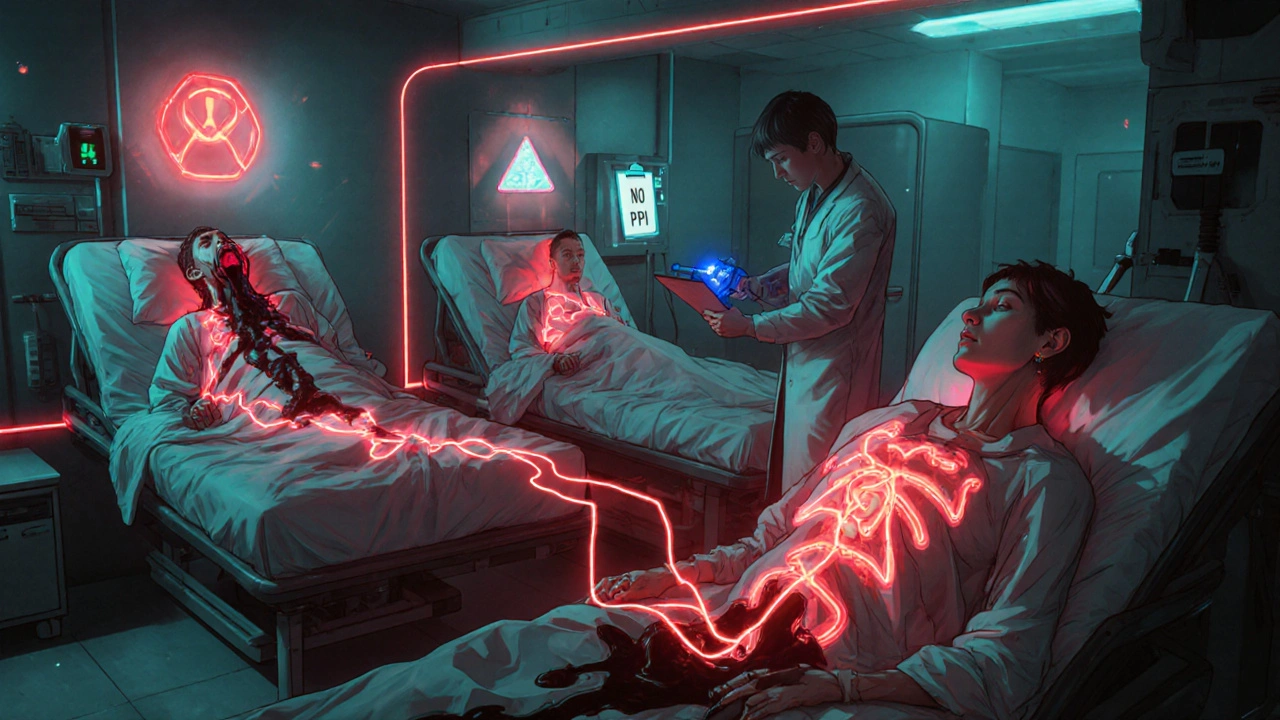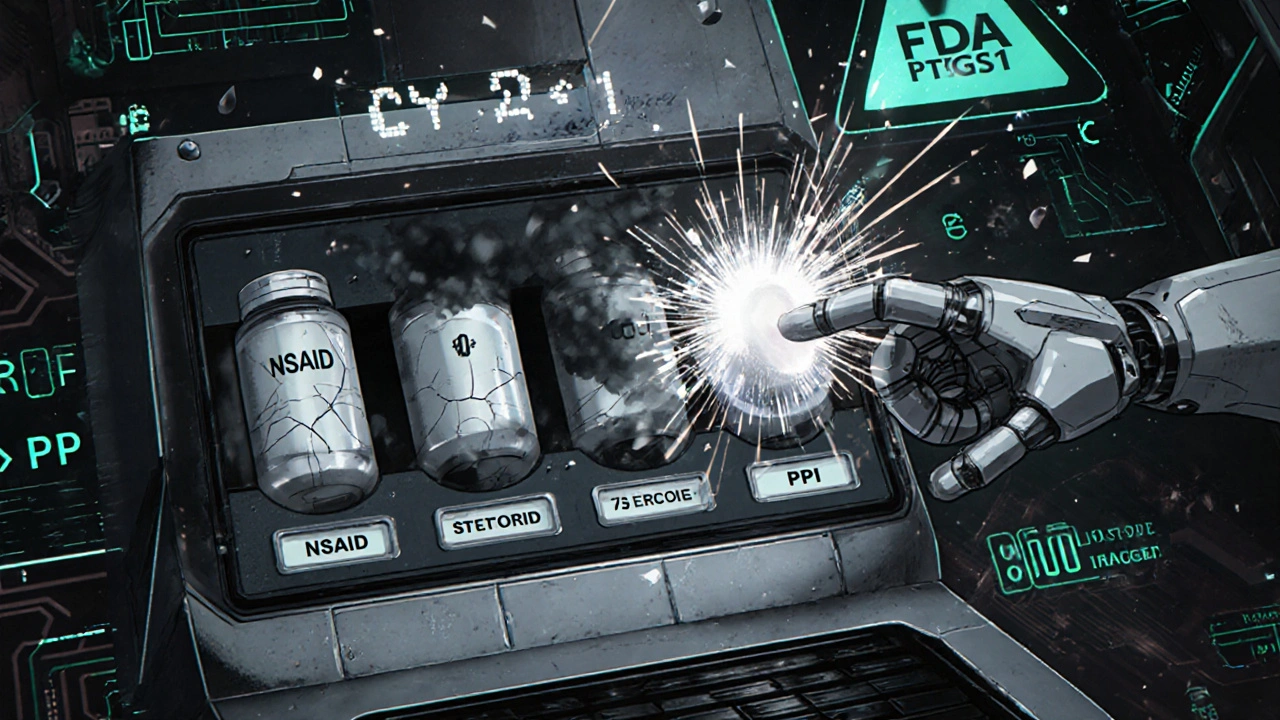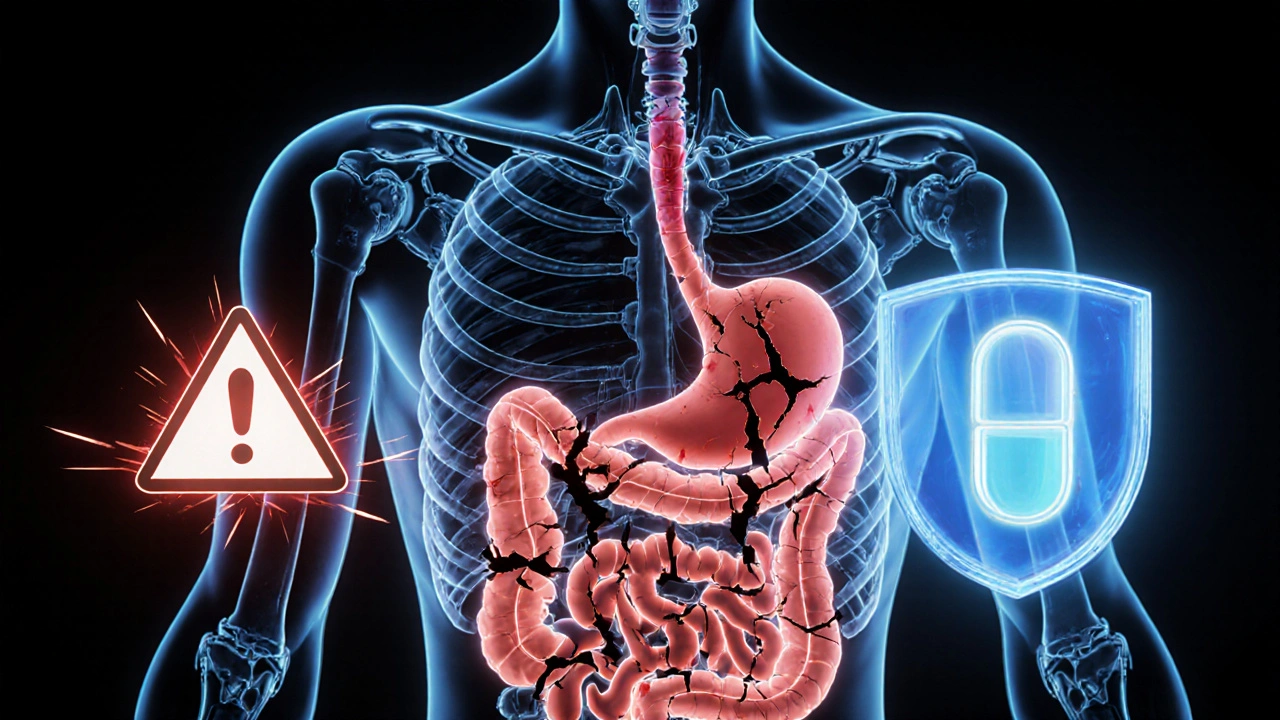Steroid-NSAID Risk Calculator
Assess your gastrointestinal bleeding risk when taking steroids and NSAIDs together
Your Risk Factors
Your Risk Assessment
Calculate your risk by selecting your factors above
Protection Needed: PPI medication (e.g., omeprazole 20mg daily)
Combining steroids and NSAIDs might seem like a simple way to manage pain and inflammation-especially if you're dealing with arthritis, a flare-up, or a recent injury. But here’s the hard truth: steroids and NSAIDs together can turn a routine prescription into a life-threatening situation. This isn’t a rare side effect. It’s a well-documented, predictable, and preventable danger that doctors miss far too often.
Why This Combo Is So Dangerous
NSAIDs like ibuprofen, naproxen, and diclofenac work by blocking enzymes that cause pain and swelling. But they also block a protective enzyme called COX-1, which keeps your stomach lining healthy. Without it, your stomach makes less mucus, blood flow drops, and the lining becomes vulnerable to damage. That’s why NSAIDs alone can cause ulcers and bleeding-even in people who’ve never had stomach issues. Now add steroids-like prednisone or methylprednisolone. These drugs don’t just reduce inflammation. They slow down healing, reduce mucus production even further, and hide the warning signs. A patient on both might develop a bleeding ulcer and feel fine until they suddenly vomit blood or pass black, tarry stools. By then, it’s often too late. Research from the American Journal of Epidemiology shows that taking both drugs together increases the risk of upper GI bleeding or perforation by nearly 9 times compared to taking neither. In high-dose cases-like someone on 40mg of prednisone and 1200mg of ibuprofen daily-that risk jumps to over 12 times higher. And it’s not just about long-term use. The danger kicks in within days. Studies show significant risk elevation as early as 7 days after starting the combo.It’s Not Just Your Stomach
Most people think GI bleeding means an ulcer in the stomach or duodenum. But nearly one-third of NSAID-related bleeds happen in the lower GI tract-colon or small intestine. And when steroids are added, the risk doesn’t just shift; it multiplies. A 1999 study found that 86% of patients with lower GI bleeds had taken NSAIDs. Steroids make those bleeds more likely and harder to catch early because they mask symptoms like pain or cramping. And it gets worse if you’re on blood thinners. Warfarin, apixaban, or aspirin combined with NSAIDs and steroids? That’s a triple threat. One study found patients on all three had over a 13-fold higher risk of major GI bleeding. This isn’t theoretical. Emergency rooms see these cases every week.Not All NSAIDs Are Created Equal
If you must take an NSAID while on steroids, the choice matters. Traditional NSAIDs (tNSAIDs)-like naproxen, ibuprofen, and diclofenac-are the worst offenders. They block both COX-1 and COX-2 enzymes, wiping out your stomach’s natural defenses. COX-2 inhibitors like celecoxib are safer. Studies like CLASS and VIGOR showed they cut upper GI bleeding risk by 50-60% compared to tNSAIDs. The CONCERN trial in 2017 found that for patients needing both aspirin and an NSAID, celecoxib plus a PPI reduced recurrent bleeding by 54% compared to naproxen plus PPI. But here’s the catch: even celecoxib isn’t risk-free when paired with steroids. The risk is lower, but it’s still there. And in patients over 65 or with prior ulcers, even small doses can be dangerous.
What Actually Works: The Only Proven Protection
The American College of Gastroenterology, the American Gastroenterological Association, and the European Society of Gastrointestinal Endoscopy all agree: if you’re on steroids and NSAIDs together, you need a proton pump inhibitor (PPI). Not an H2 blocker like famotidine. Not antacids. Not just “avoiding spicy food.” PPIs-like omeprazole, esomeprazole, or pantoprazole-shut down stomach acid production at the source. They’re the only drugs proven to prevent NSAID-steroid ulcers. Studies show PPIs reduce ulcer risk by 73% compared to no protection. H2 blockers? They only cut it by 48%. That’s a huge gap. Standard dose: omeprazole 20mg once daily. For high-risk patients-those over 65, with prior ulcers, on blood thinners, or taking high-dose NSAIDs-double the dose: 40mg daily. And don’t stop the PPI early. If you’re on steroids for 2 weeks and NSAIDs for 6, the PPI needs to cover the full course. Stopping it after 7 days because “you feel fine” is a common and deadly mistake.Why Doctors Keep Missing This
A 2022 study of over 12,000 hospital admissions found that only 39% of patients on both steroids and NSAIDs got a PPI. In non-rheumatology clinics-where most of these prescriptions happen-the rate dropped to just 22%. Why? Many doctors don’t realize how dangerous the combo is. Others assume the patient is “just taking ibuprofen for a headache” and don’t connect it to the prednisone they prescribed for a flare. Patients often don’t tell their doctors about OTC NSAIDs. And many assume that because they’ve been on the drugs for a while without problems, they’re safe. One gastroenterologist on Reddit summed it up: “I see preventable bleeds weekly from primary care providers starting prednisone bursts in patients already on chronic ibuprofen without adding PPIs.” The FDA requires GI bleeding warnings on NSAID labels-but doesn’t specifically mention the steroid interaction. That leaves a dangerous gap in awareness.
What You Can Do Right Now
If you’re on steroids and NSAIDs together, here’s your action plan:- Ask your doctor: “Am I at risk for GI bleeding?”
- If you’re on both, insist on a PPI-omeprazole 20mg daily is the baseline.
- Don’t take OTC NSAIDs like Advil or Aleve unless your doctor says it’s safe.
- If you’ve had an ulcer before, ask for double-dose PPI (40mg).
- If you’re on blood thinners, ask if you can switch to a COX-2 inhibitor like celecoxib.
- Watch for warning signs: black stools, vomiting blood, sudden severe abdominal pain, dizziness, or unexplained fatigue.
New Options Are Coming
In 2023, the FDA approved Vimovo-a single pill combining naproxen and esomeprazole-for high-risk patients. Early data shows it cuts endoscopic ulcers by 54% compared to naproxen alone. This is a big step forward, but it’s still not widely used or covered by insurance for everyone. Researchers are also looking at genetics. Some people have variations in the CYP2C9 or PTGS1 genes that make them far more susceptible to NSAID-steroid damage. In the next few years, genetic testing might help identify who needs the strongest protection.The Bottom Line
Steroids and NSAIDs together are not a harmless combo. They’re a ticking time bomb for your digestive tract. The good news? This risk is almost entirely preventable. You don’t need to avoid either drug if you need them. But you do need to protect your stomach. If you’re prescribed both, don’t wait for symptoms. Ask for a PPI before you even fill your first prescription. It’s one of the few times in medicine where a simple, cheap, and safe intervention can prevent a life-threatening event. And if your doctor says, “You’ll be fine”-get a second opinion. This isn’t guesswork. It’s evidence-based medicine. And the evidence is clear: protect your gut, or pay the price.Can I take ibuprofen with prednisone if I’m only on it for a few days?
Yes, but only with a proton pump inhibitor (PPI) like omeprazole. Even short-term steroid bursts-7 days or less-combined with NSAIDs can trigger GI bleeding. The risk starts within days, and symptoms can be silent until it’s too late. Don’t assume short-term use is safe without protection.
Is it safer to use a COX-2 inhibitor like celecoxib instead of naproxen with steroids?
Yes, celecoxib and other COX-2 inhibitors carry about 50-60% lower risk of GI bleeding than traditional NSAIDs like naproxen or ibuprofen-even when taken with steroids. However, they’re not risk-free. Always pair them with a PPI if you’re on steroids, especially if you’re over 65 or have a history of ulcers.
Can I use famotidine (Pepcid) instead of a PPI for protection?
No. H2 blockers like famotidine are significantly less effective than PPIs at preventing NSAID-steroid ulcers. Studies show PPIs reduce ulcer risk by 73%, while H2 blockers only cut it by 48%. If you’re on both steroids and NSAIDs, PPIs are the only recommended option. Don’t substitute.
What are the warning signs of GI bleeding from this combo?
Black, tarry stools; vomiting blood or material that looks like coffee grounds; sudden, severe abdominal pain; dizziness or fainting; unexplained fatigue or weakness. Steroids can mask pain, so don’t wait for stomach discomfort. If you notice any of these signs, seek emergency care immediately.
Are over-the-counter NSAIDs dangerous with steroids too?
Absolutely. Many people don’t realize that taking Advil, Aleve, or aspirin daily while on prednisone is just as risky as prescription NSAIDs. OTC doesn’t mean safe. In fact, patients often don’t tell their doctors they’re taking these, which makes the risk even higher. Always disclose all medications, including OTCs, to your provider.
Can I stop the PPI once I feel better?
No. The risk of bleeding lasts as long as you’re taking both steroids and NSAIDs. Stopping the PPI early-even if you feel fine-is a common mistake that leads to preventable bleeds. Continue the PPI for the entire duration of your steroid and NSAID treatment. If your treatment lasts 6 weeks, the PPI should last 6 weeks.
